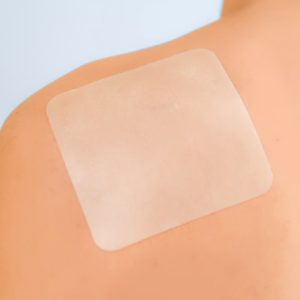Description
Product Info
The Pharmacoll® product line represents a gelatine free hydrocolloid wound dressing that convert into a gel when in contact with wound fluid. The moist wound environment created under the dressing speeds the natural healing process, reduces pain, and protects against bacterial and other external contaminants.
Pharmacoll®Thin and Pharmacoll® Extra Thin are gelatin free hydrocolloid adhesive wound
dressings, laminated to a semi-permeable, bacteria-proof, virus-proof and waterproof polyurethane film backing.
The difference between the 3 variants is the thickness of the hydrocolloid layer,
Pharmacoll® is 1 mm thickness
Pharmacoll® Thin is 0.6 mm
Pharmacoll® Extra Thin is 0.3 mm
• Adhere to both dry and moist skin surfaces.
• Deliver gentle and secure adhesion that does not irritate the skin.
• Have fluid absorption capacity that is adjustable based on adhesive formula.
• Provide barrier properties to external contaminants with secure adhesion to skin.
• Are flexible and conformable and mold to difficult anatomical contours.
-
- Partial- and full-thickness dermal ulcers.
- Pressure, Leg and Diabetic ulcers.
- Burns (First and Second Degrees).
- Skin Donor sites and Skin grafts.
- Superficial wounds/minor abrasions.
- Protection of fragile skin or areas exposed to friction such as elbows, heels or the sacral area.
- Ostomy wounds to protect the skin from stomal effluent.
- Post-op dressings for suture line protection.
- Infants Diaper rash.
Don’t use on patient with known sensitivity to the product or any of its components specially Polyisobutenes and Carboxymethylcellulose.
1- Discoloration and bulging of the dressing indicate it should be changed
2- Wounds showing clinical signs of infection (temperature, pus, inflammatory signs) should be treated
under medical control before resume using of the dressing
Thick hydrocolloid island pad placed in the middle of a thin hydrocolloid layer.
The thin hydrocolloid layer is laminated with a semi permeable, bacteria proof, viral proof and waterproof polyurethane film.
When Pharmacoll® dressing comes into contact with wound exudates, the hydrocolloid swells and forms a gel that
covers the wound and maintains moisture. This gel continues absorbing the wound fluid and minimizes adherence
to the wound. When the dressing is changed, the wound stays protected by a film of gel.
- Clean wound area.
- Evaluate the wound and select the dressing size to allow 2.5 cm (1 inch) of the hydrocolloid adhesive to extend beyond the wound edge.
- Open the pouch and handle the dressing using gloves/forceps.
- Remove the release liner from the dressing.
- Center the dressing over the wound and the periwound area, then gently press the adhesive side of the dressing.
- Care should be taken to avoid unnecessary stretching of the dressing, which can result in mechanical trauma to the wound and surrounding skin.
Dressing Removal:
- Carefully lift the dressing edges (or film border) while pressing down on the skin
- Continue lifting the edges until all are free from the skin surface.
- Press down on skin to separate dressing from skin.
- Gently remove the dressing then folding it over itself with Pulling carefully in the direction of hair growth.
- Alternatively, stretching the dressing horizontally and lifting it will also facilitate removal in most situations.
- Discard the dressing into appropriate recycle bin.
How often to change the
dressing:
- The dressing should remain in place as long as possible.
- If leaks are detected, the dressing should be changed immediately.
- Change the dressing when maximum absorption has been reached.










Reviews
There are no reviews yet.